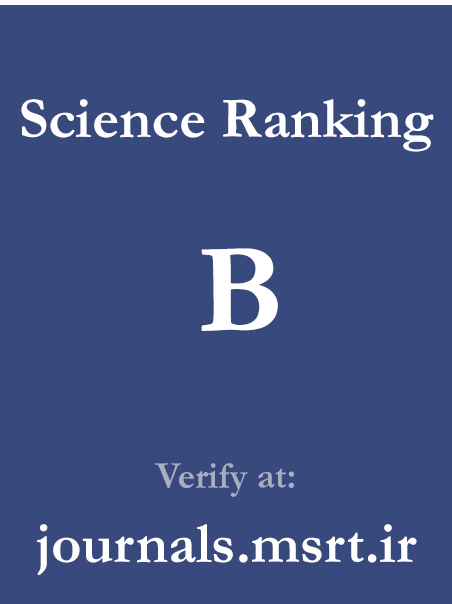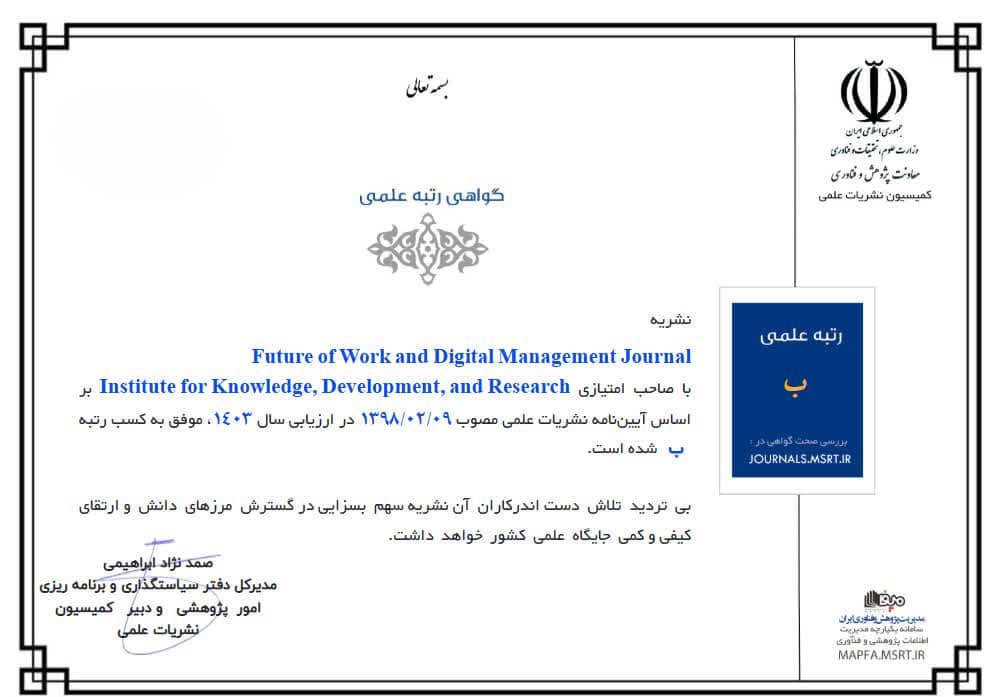The Effect of Green Human Resource Management on Green Reputation: Explaining the Mediating Role of Organizational Identity, Green Innovation, and Green Entrepreneurial Orientation (Case Study: Hospitals of Tabriz City)
Keywords:
Green Human Resource Management (GHRM), Green Reputation, Green Organizational Identity, Green Innovation, Green Entrepreneurial Orientation, HospitalAbstract
With the growing strategic importance of sustainability in the healthcare sector, building a green reputation has become one of the key challenges for hospitals. The present study aims to investigate the effect of Green Human Resource Management (GHRM) on the green reputation of hospitals in Tabriz. In addition, the mediating roles of three complementary mechanisms—green organizational identity, green innovation, and green entrepreneurial orientation—are analyzed in this relationship. This study employed a descriptive–survey research design. Data were collected through a structured questionnaire based on a five-point Likert scale from 350 hospital employees. Data analysis was conducted using Structural Equation Modeling (SEM) with the Partial Least Squares (PLS) approach. The results revealed that GHRM has a direct and significant positive effect on green reputation. Furthermore, all three variables—green organizational identity, green innovation, and green entrepreneurial orientation—played significant mediating roles in this relationship. These findings indicate that the impact of GHRM on reputation mainly occurs through its capacity to strengthen internal identity, promote tangible innovations, and encourage an entrepreneurial orientation within the organization. The results highlight the necessity for hospital managers to adopt a multifaceted approach, meaning that investment in GHRM policies should be accompanied by efforts to institutionalize environmental identity, support visible innovative projects, and empower employees’ entrepreneurial behaviors. Despite the increasing importance of green reputation, the precise mechanisms through which internal green HRM practices translate into external reputation—especially the concurrent roles of identity, innovation, and entrepreneurship—have been less explored. This study was designed to address this knowledge gap and clarify these multi-path mechanisms in Iran’s healthcare sector.
Downloads
References
[1] A. L. Soares et al., "A review of the applicability of current green practices in healthcare facilities," International Journal of Health Policy and Management, vol. 12, p. 6947, 2023, doi: 10.34172/ijhpm.2023.6947.
[2] J. S. Velmurugan, "A review on green human resource management in hospitals: Paving the way for sustainable development goals," 2024.
[3] X. Wang, R. S. Wang, X. Qin, Y. N. Huang, H. C. Chiu, and B. L. Wang, "Exploring human resource management in the top five global hospitals: a comparative study," Frontiers in Public Health, vol. 11, p. 1307823, 2024, doi: 10.3389/fpubh.2023.1307823.
[4] J. Dumont, J. Shen, and X. Deng, "Effects of green HRM practices on employee workplace green behavior: The role of psychological green climate and employee green values," Human resource management, vol. 56, no. 4, pp. 613-627, 2017, doi: 10.1002/hrm.21792.
[5] S. M. Fayyazi and S. M. Aghar, "Necessary Platforms for the Implementation of Green Human Resource Management in the Oil Industry," Quarterly Journal of Strategic Studies in Oil and Energy Industry, vol. 6, no. 24, pp. 181-201, 2015.
[6] B. S. Al-Romeedy and T. Alharethi, "Leveraging green human resource management for sustainable tourism and hospitality: A mediation model for enhancing green reputation," Discover Sustainability, vol. 6, no. 1, p. 67, 2025, doi: 10.1007/s43621-025-00829-2.
[7] A. M. D. Sitohang, Y. Absah, H. Harahap, and R. Sibarani, "The role of green human resource management in promoting sustainable tourism practices," in E3S Web of Conferences, 2024, vol. 577: EDP Sciences, p. 02013, doi: 10.1051/e3sconf/202457702013.
[8] A. D. G. Atalla, A. M. El-Ashry, and S. M. K. Khattab, "Fostering eco-friendly excellence: exploring the relationship between green human resource practices and organizational environmental performance as perceived by nurses: a cross-sectional study," BMC nursing, vol. 24, no. 1, p. 495, 2025, doi: 10.1186/s12912-025-03097-7.
[9] N. G. N. S. Murni, I. N. Winia, I. W. Pugra, and I. M. D. Oka, "Implementation of green human resource management in jatiluwih tourism destination area," Journal of World Science, vol. 2, no. 1, pp. 101-108, 2023, doi: 10.58344/jws.v2i1.119.
[10] M. A. Rahman and N. A. Saba, "Driving Sustainable Business Performance through Green HRM: Examining the Mediating Roles of Green Technology Innovation and Green Organizational Culture," Golden Ratio of Human Resource Management, vol. 5, no. 2, pp. 501-516, 2025, doi: 10.52970/grhrm.v5i2.1326.
[11] P. Pardiman, "The Effect of Green Job Design on Employee Behavior in Indonesian Hospitals: A Mediation Model," 2025.
[12] Y. S. Chen, "Green organizational identity: sources and consequence," Management decision, vol. 49, no. 3, pp. 384-404, 2011, doi: 10.1108/00251741111120761.
[13] N. Ya'qubi, Nourmohammad, Dehghani, and Ahmadi, "The Role of Green Organizational Culture in Human Resource Productivity with the Mediating Role of Green Performance in Imam Reza (A.S.) Hospital Nurses, Mashhad," Khorasan Socio-Cultural Studies, vol. 15, no. 2, pp. 149-178, 2021.
[14] M. Talebi and A. Moazezikhah Tehran, "Investigating the Relationship Between Green Innovation Strategy and Green Innovation Mediated by Organizational Environmental Legitimacy and Green Organizational Identity," Industrial Management Outlook, vol. 13, no. 2, pp. 159-186, 2023.
[15] A. Salehi, H. Arefnezhad, Hasanvand, and Hakkak, "The Impact of Innovation Strategies and Green Information Systems on Green Innovation with the Mediating Role of Green Organizational Identity and Environmental Organizational Legitimacy," Journal of Natural Environment, vol. 77, no. 2, pp. 227-239, 2024.
[16] N. Morovati Sharifabadi, J. Namakshanas, and Ziaeideh, "Investigating the Impact of Green Innovation Dimensions on Organizational Performance," Industrial Management Studies, vol. 12, no. 33, pp. 25-42, 2014.
[17] W. Jiang, H. Chai, J. Shao, and T. Feng, "Green entrepreneurial orientation for enhancing firm performance: A dynamic capability perspective," Journal of cleaner production, vol. 198, pp. 1311-1323, 2018, doi: 10.1016/j.jclepro.2018.07.104.
[18] H. T. Pham, T. Pham, H. Truong Quang, and C. N. Dang, "Impact of transformational leadership on green learning and green innovation in construction supply chains," Engineering, construction and architectural management, vol. 30, no. 5, pp. 1883-1901, 2023, doi: 10.1108/ECAM-05-2021-0379.
[19] Y. Zhao, Y. Li, S. H. Lee, and L. Bo Chen, "Entrepreneurial orientation, organizational learning, and performance: Evidence from China," Entrepreneurship theory and practice, vol. 35, no. 2, pp. 293-317, 2011, doi: 10.1111/j.1540-6520.2009.00359.x.
[20] R. Khosravipour and Kourepaz, "The What and Why of Green Entrepreneurship and Its Relationship with Green Innovation," Geography and Human Relations, vol. 4, no. 4, pp. 145-160, 2022.
[21] A. Bouhalleb and K. Messeghem, "Exploring the impact of dynamic capabilities on entrepreneurial orientation in healthcare organizations: Findings from symmetric and asymmetric modeling," Management international, vol. 28, no. 6, pp. 7-20, 2024, doi: 10.59876/a-gygn-yawn.
[22] H. Pakfetrat and O. Behboudi, "Green Entrepreneurship on Green Supply Chain Management and Sustainable Performance: An Analysis of the Role of Market Orientation and Knowledge Management Orientation in Mashhad Municipality," Green Development Management Studies, vol. 2, no. 1, pp. 139-157, 2023.
[23] R. Bashirkhodaparasti and H. Bagheri Ghareh Bolagh, "Analysis of the Role of Brand Orientation and Entrepreneurial Orientation on Brand Performance in Green Food Manufacturing Companies," Entrepreneurship Strategies in Agriculture, vol. 7, no. 14, pp. 11-20, 2020, doi: 10.52547/jea.7.14.11.
[24] E. Ari, O. M. Karatepe, H. Rezapouraghdam, and T. Avci, "A conceptual model for green human resource management: Indicators, differential pathways, and multiple pro-environmental outcomes," Sustainability, vol. 12, no. 17, p. 7089, 2020, doi: 10.3390/su12177089.
[25] B. Mohammadi, Baghbani, and Hosseini, "Identifying the Impact of Green Human Resource Management and Corporate Social Responsibility (CSR) on Sustainable Performance with the Mediating Role of Organizational Citizenship Behavior for the Environment in Imam Reza (A.S.) Hospital, Ardabil Province," Strategic Studies in Business, vol. 1, no. 2, pp. 1-15, 2024.
[26] S. Rahimiaghdam and T. Niroumand, "Analyzing the relationship between perceived social responsibility and employees' affective commitment and green behaviors: mediating role of ethical climate," International Journal of Ethics and Society, vol. 4, no. 1, pp. 1-9, 2022, doi: 10.52547/ijethics.4.1.1.
[27] S. Rahimiaghdam, R. Babazadeh, and M. Shamsi, "Analysis of the relationship between competency-based factors of competitive advantages: a case of the insurance industry," International Journal of Technology, Policy and Management, vol. 22, no. 4, pp. 306-324, 2022, doi: 10.1504/IJTPM.2022.126138.
[28] P. Akbari, Dehghanizadeh, and Kasaei, "The Impact of Green Human Resource Management (GHRM) Practices on Intention to Leave: The Mediating Role of Work Environment Conditions," Green Development Management Studies, vol. 1, no. 2, pp. 1-12, 2022.
[29] A. Vaziri, P. Sadatian Moghaddam, and A. Ershadi Oskouei, "Development of Service Compositions in Cloud Manufacturing Processes Based on System Sustainability Components," Journal of Electrical Systems, vol. 19, no. 4, 2024, doi: 10.52783/jes.6257.
[30] P. Sadatian Moghaddam, A. Vaziri, and A. Ershadi Oskouei, "A New Algorithm for Indoor Robot Localization using Turning Function," Computational Methods for Differential Equations, 2024.
[31] J. Henseler, C. M. Ringle, and M. Sarstedt, "A new criterion for assessing discriminant validity in variance-based structural equation modeling," Journal of the academy of marketing science, vol. 43, no. 1, pp. 115-135, 2015, doi: 10.1007/s11747-014-0403-8.
Downloads
Published
Submitted
Revised
Accepted
Issue
Section
License
Copyright (c) 2024 Mehdi Foroughi, Samad Rahimi Aghdam (Author)

This work is licensed under a Creative Commons Attribution-NonCommercial 4.0 International License.








